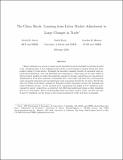The China Shock: Learning from Labor Market Adjustment to Large Changes in Trade
Author(s)
Autor, David H.; Dorn, David; Hanson, Gordon H.
DownloadADH-China-ARE-Feb23-2016.pdf (1.528Mb)
OPEN_ACCESS_POLICY
Open Access Policy
Creative Commons Attribution-Noncommercial-Share Alike
Terms of use
Metadata
Show full item recordAbstract
China’s emergence as a great economic power has brought an epochal shift in patterns of world trade. This shift has toppled much of the received empirical wisdom about how labor markets adjust to trade shocks. Alongside its heralded consumer benefits, trade has both significant distributional costs, which theory has long recognized, and substantial adjustment costs, which the literature has tended to downplay. These adjustment costs mean that trade impacts are most visible not in national-level outcomes for broad skill types, as canonical theory would suggest, but in the local labor markets in which the industries most exposed to foreign competition are concentrated. Adjustment in local labor markets is remarkably slow, with wages and local laborforce participation rates remaining depressed, local unemployment rates remaining elevated, and public transfer benefits take-up rising across a spectrum of programs for at least a full decade after trade shocks commence. Within impacted localities, the workers who are most affected by rising trade exposure are those initially employed in firms that compete most directly with China. These workers, and in particular those in lower earnings deciles, experience greater job churning and reduced lifetime income. Recent literature also addresses the aggregation of local-level impacts of trade shocks into national-level outcomes. Employment has fallen in U.S. industries more exposed to import competition, as expected. So too has overall employment in the local labor markets in which these industries were concentrated. Offsetting employment gains in non-tradables, export-oriented tradables, or imported-input-using industries have yet to materialize. Better understanding when and where trade is costly, and how and why it may be beneficial, are key items on the research agenda for trade and labor economists.
Date issued
2016-08Department
Massachusetts Institute of Technology. Department of EconomicsJournal
forthcoming in Annual Review of Economics
Publisher
Annual Reviews
Citation
Autor, David H., David Dorn and Gordon H. Hanson. "The China Shock: Learning from Labor Market Adjustment to Large Changes in Trade." Forthcoming in Annual Review of Economics, Vol. 8 (Volume publication date September 2016).
Version: Author's final manuscript